Caught Between Media Mayhem
and a Tranquil Info Rest Area:
Reynald Drouhin
Om
March 2001
and Nancy Tobin
Rest Area
20011
It is a platitude to say that we live in a culture of media saturation and technological overdrive. True enough, but platitude or not, there is certainly no limit to artistic commentaries on the state of our global infoscape. Reynald Drouhin's website Om, and Nancy Tobin's Rest Area are based on diametrically opposed artistic approaches to information overload in a pan-mediated world. On the one hand, Om pushes the envelope to the extreme by creating an escalating aural bombardment of sound layers emanating from a busy visual collage. While on the other, Nancy Tobin has opted for a maximum filtering out of extraneous information with her minimal web installation Rest Area. A soothing, quiet and well tempered site that can, however, only be read in relation to a media world of endless stimulation.
Om, has nothing to do with the homonymous mantra, on the contrary the site induces a state of relentless but amusing enervation. The visuals consist of a large quilt collage of static square images in the shape of children's memory game (side by side images of an orange, stars, sun, gramophones, cat etc.). As one enters the site a rectangle replete with these square images rapidly zooms out to a near full frame display. The rectangle is made up of nine by eight lines for a total of 72 squares and 72 different images. Clicking on any image triggers a sound loop that is unique to that image. For instance clicking on one of the sun shapes activates an excerpt from an American advertisement; the orange triggers a masculine orgasmic groan, the bicycle a heavy metal song etc. For the most part these 'innocent' looking images conceal nasty, unpleasant, noisy snippets lifted from our media landscape. Playing just one looped sound already alerts you to the fact that this collage of loops was not conceived with quiet in mind. The first click is, however, only the beginning of a chain of layered loops that grow increasingly maddening in their insistence and endless repetition. After having set one visual square into aural motion, one intuitively clicks another one, which sets off another sound over the first, and so forth. The result is a truly bewildering cacophony of looped layers of radio voices, sampled porn film groans and moans, lullabies, jingles, barking dogs, aggravating pop songs etc. It is like running all manner of media output at the same time with a consequent and inevitable sense of disorientation. No repose whatsoever is permitted here, on the contrary Om is an in the face collage of media looped noise that ultimately leaves you running for the quit button. Somewhere between a toy interface and a dadaist inspired sound collage, the site is a biting commentary on the rampant stupidity that the media have accustomed us to. The amusing aggravation ultimately makes one reflect on how numbed we have become to the endless drone of mediated auditory messages (particularly in North American). The clever use of sound loops in conjunction with the child-like visual interface makes for a perhaps not enjoyable, but definitely engaging experience in media bulimia. This is highly recommended aversion therapy for a world full of sound and media fury.
If Om has left you somewhat frazzled and on edge the antidote is to seek some soothing rest at Nancy Tobin's Rest Area site. This a visually and aurally pared down minimalist site that goes against the grain of the high speed clicking stimulation, banner popping accoutrements of the majority of web sites floating through the internet. Upon arrival one is asked to relax and take a five-minute break. These five minutes are the temporal unfolding and structural backbone of the work. The entry icon is a pictogram of a rest area bench, the likes of which one encounters along highways. This already semi-abstract pictogram (white and blue) is broken down into minimalist abstract rectangular shapes in the five-minute relaxation voyage. The relaxation 'site' begins on a very quiet note. A small second timer on the left-hand side of the screen discreetly displays passing seconds. A small blue rectangle floats down while a white rectangle, of equal size, moves horizontally across the top of the screen. A minimal click rhythm accompanies the tranquil journey. Always following the clicking beat the rectangles grow somewhat larger and move according to different patterns. Slowly different color rectangles join the quiet parade. Oscillating sounds accompany their entry on the scene. The layering of various colored rectangles is reminiscent of an off-air television signal. After a revolution of 60 seconds there is a slightly louder click and a reset of the ticker to 0. A slightly more complex though still minimalist minute follows. This time with rectangular color slices moving diagonally from the bottom left screen towards the top right screen. Each passing minute indicates a further mini 'chapter' in this variable relaxation geometry, until the final five-minutes is up. The minimalist chromatic components, clean geometric shapes and fine tuned micro sounds all combine to create an intriguing work of media underload that acts as welcome reprieve from the media universe referenced in the Om site.
The minimalist sonic and visual abstraction of Nancy Tobin's piece, and the baroque over-referential aural and visual machine gun fire of Reynald Drouhin's exploration are rooted in two fundamentally different and incommensurable aesthetics. Yet, in their particular ways of situating themselves in relation to a hypermediated world they provide a complimentary and mutually enriching artistic way of exploring the complexities of our forever shifting infoscapes.
Note
1- (Credits for Rest Area: Thanks to GIV (Groupe Intervention Video) and to Nicole Gingras)
B.S.
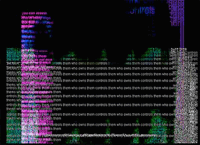 Glorious Ninth
Glorious Ninth
(Kate Southworth,
Patrick Simons)
Who_Owns_Them_Controls
November 2001
Under the name of Glorious Ninth, artists Kate Southworth and Patrick Simons produce net.art that is tightly linked to activism. Most artists who work in this genre tend to use subversive means of expressing radical ideas rather than a more militant approach of strong statements and bold affirmations. Nevertheless, net.art remains rooted in activism in the attempt to question the many different currents on the net and their socio-political and psychological impact.
Similarly to other projects produced by Glorious Ninth, Who_Owns_Them_Controls consists of words composed in slogan-like phrases and sounds. The work functions as an interactive political poster reminiscent of electronic bill-boards. In this respect, this net.art piece presents an antipode to outdoor advertising which constantly obstructs and bombards our vision. In addition, the project interrogates the proliferation of advertising on the Net in the framework of the relationship that exists between ownership of technology and dominant consumerist discourse on the Net. Its Marxist reverberations render the piece remotely as a vestige of political slogans which one could find in proliferation in former communist regimes. On the other hand, it is clear that in this project the artists do not choose to fight coercion by substituting it with another kind of coercion.
Inscribed on a black background and written in different colours, the phrases are represented as bleeding data. The phrases are layered one over the other running like waves of water over the black surface, crawling up and sliding down. The leitmotif is who owns them controls them which resonates both as a statement and a question. A buzzing, ambient-like sound functions as part of the background and diffuses the categorical overtones of the sentences. The ambiguity is further accentuated by the visual composition of the words in different colours which become blurred and superimposed during their vertical movement of ascending and descending. The sound phrase is composed of two main elements : one is splintering and ascending and the other dissipating and descending. Thus, the artwork draws on a veiled, inward pattern of parallelism between sights and sounds. In these respects the statements become less affirmative and open the work to many interpretations and degrees of perception making the work interactive on a conceptual plane.
The user is confronted with a single page. It appears that he/she is not able to move and that he has no control over the information streaming on the screen. However, as one enters the site, he/she first notices words appearing in white, letter by letter in the lower middle of the frame as if the user is writing them right at this moment. As they emerge, they become etched into the black surface and endow the overall controlled whole with a touch of improvisation. We read : "You can access this in many ways." Just like a secret message written in the sand, new waves of words cover it sweeping it away.
The entire piece is musically composed of visuals, sounds and words. On the right side of the of the frame the data is glued together in a motionless, amorphous pastiche from which data detaches itself and strings out horizontally and vertically over the screen. On the left side, the inscription "You can access this in many ways." reappears in pink letters and as a counterpoint "Themselves" emerges on the screen in grey with the movement of the cursor while interrupting the sound flow. Here, the viewer becomes involved. His/her manipulation (movement of the hand) leaves traces and mediates between the two poles of control based on ownership and other possibilities for access.
In a response to questionnaire for Soundtoys the artists state :
"On yet another level, like much of our work, this project focuses on the constant flow of change in our complex world. There is always movement away from one thing and towards something else, but if the change takes place too slowly then we often ignore it. This piece constantly changes as the different elements within it interact with each other. However, it sometimes seems like there is monolithic inactivity. At other times monumental changes are easier to perceive."
The experience of the artwork is in the encoding and decoding. Its regenerative character reveals the absurdity of ownership of information and power over communication. The impenetrable darkness of the void (the black background) is seething with chaos, traps and many possibilities of experience.
R.D.
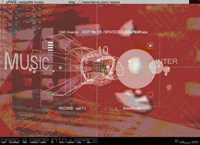 LAB(au)
LAB(au)
(Manuel Abendroth,
Jerome Decock,
Alexandre Plennevaux)
sPACE, navigable music
2001
The sPACE, navigable music project is conceived a unique interactive audio-visual environment of structures and forms that like a living organism can reproduce and regenerate. The menu itself has the configuration of a spiral-like planetary system: there are three different rings that each light up when selected. Furthermore as the cursor runs over the menu different geometrical representations light up in either red ('read' theoretical researches), blue ('experiment' interactions in a real-time 3D space relating architecture, music and cinema) or white ('explore' navigable music where users can create a music video clip by dropping sounds and recording their movements in the sound/space architecture). Thus, the separate elements of the menu enter into different configurations and suggest inter-relatedness. It represents a net or a web in which the dynamic inter-connectedness of components exhibits a network.
Entering into a particular audio-visual space, the beholder is thrown into what resembles a pulsating corridor. From the exterior the whole structure looks like the cross-section of a tunnel. Its interior four walls with shifting textures and colours are fluid so that one easily traverses them and penetrates into another space. They move from green to black and blue to shades of red. If the mouse is kept still then the environment seems to pulsate resembling a breathing body. Sliding along the walls, words and numbers are floating from the depths of the corridor toward us and away suggesting travelling.
This traversal which is not unlike an osmosis erases previous confinements and transports the user into new spaces while allowing a clearer view of those boundaries. The texture is a fusion of aural and visual elements as the walls which function as sensitive membranes are impregnated with the sounds. A similar vision of a certain lucid dream-scape was once described by Brian Eno in the following manner :
"I realised I had been moving towards a music that had this feeling: as the listener, I wanted to be situated inside a large field of loosely-knit sound, rather than placed before a tightly organised monolith (or stereolith, for that matter). I wanted to open out the aural field, to put much of the sound at a considerable distance from the listener (even locating some of it 'out of earshot'), and to allow the sounds to live their lives separately from one another, clustering occasionally but not 'musically' bound together."1
In the amalgamation of the elements the project demonstrate a phenomenon of splintering the space-time parameters into elastic strings. The whole constitutes a creation of a vivid habitat, a moving, transformable architecture of sights and sounds endowed with plasticity. Its interior and the exterior consist of grids that can be associated with frames and modules within which this polymorphous digital space is molded. sPACE, navigable music proposes a model of the Net experience. It investigates the matter, the architectonics, as well as the dimensions of the digital universe.
Note
1- Brian Eno, Ambient Music, 1982.
http://homestudio.thing.net/revue/content/ambient.htm
R.D.
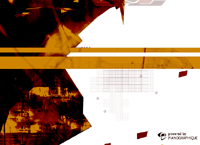 Jean-Luc Lamarque
Jean-Luc Lamarque
Pianographique
December 1999
QWERTY Beats:
Jamming with the Pianographique
Since the explosion of the internet, there have been a growing number of Flash games that are
music machines, resembling the old analog/digital drum machines of the '80s. Today's version
features samples and loops of audio, and in some cases, image manipulation/creation as well.
In truth these players are closer to mixers than beat boxes: the user does not program
individual notes, but instead triggers loops and single accents and combines (mixes) them.
This allows non-musicians to get a taste of what it's like to mix and scratch samples without
having to master turntable techniques. By choosing the sounds and layering them, the
once-passive listener becomes involved in the creation of music. Since the source material is
prepared in advance, one could argue that this is a kind of paint-by-number exercise. Yet
when using these virtual samplers, the Flash amateur dj is not told where to place the sounds
in time, leaving plenty of room for exploration and improvisation.
Some, like Crash!Media's wonderful Looplabs, are almost complex enough
to need some mixing experience. Others, like Blue Universe
are almost as difficult to look at as they
are to understand, or, as with Cymbalism, look great, but can
easily bring your browser crashing down. Le Pianographique is
very user-friendly, has inspiring sounds and images, and can take plenty of qwerty flurries
without flinching.
Learning how to use France's Pianographique is as simple as child's play: hit the letter keys
on your qwerty computer keyboard and click on the mouse while moving the pointer in the
canvas. After selecting a player, music samples are loaded up into your computer's RAM. This
means that you have immediate response to your key taps. It's actually played best in a duo,
with a dedicated mouse clicker. The site offers 5 versions of the player, each one in a
particular musical style - drum and bass, jazz, hip-hop , techno and world beat. The sound
set for each player features a generous bag of matching drum and bass loops, synth and guitar
lines, single hits, shouts, etc. The images that pop up in sync to the sounds are also based
on the player's themes, and a few minutes of jamming will result in a new improvised collage.
While Angular Entropy (drum and bass, offers adventurous sounds and cryptic visuals inspired
by science-fiction, the Compulsion (jazz) version of the game is my favourite, with its
cutouts from the great jazz record covers from the 60s.
While not directly an academic tool, Pianographique does offer non musicians a chance to
experiment with building a song, layer by layer. By offering the audition and triggering of
individual musical elements, it allows for any user to increase their awareness of how
isolated samples come together to create music.
This game is solid: I tried crashing it by typing as many letters as I could, but all I
succeeded in doing was a loop soup with matching messy napkin. The only thing missing is the
ability to record your 'performance'. For that, you'll need to plug your computer audio card
output to an MP3 recorder or to your uncle's old cassette recorder.
It is not essential to have high-speed access in order to play it, but you will need
Macromedia's Shockwave plug-in. It's available for free download from http://www.shockwave.com.
N.B.
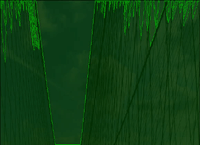 Hidekazu Minami
Hidekazu Minami
Infrasonic Soundscape
June 2001
"Let us cross a great modern capital with our ears more alert than our eyes, and we will get enjoyment from distinguishing the
eddying of water, air and gas in metal pipes, the grumbling of noises that breathe and pulse with indisputable animality, the
palpitation of valves, the coming and going of pistons, the howl of mechanical saws, the jolting of a tram on its rails, the cracking of whips, the flapping of curtains and flags. We enjoy creating mental orchestrations of the crashing down of metal shop blinds,slamming doors, the hubbub and shuffling of crowds, the variety of din, from stations, railways, iron foundries, spinning wheels,printing works, electric power stations and underground railways. "1
Acousmate. n. (from the Greek Akousma, what is heard): Imaginary sound, or of which the cause is not seen.
In Hidekazu Minami's Infrasonic Soundscape, we encounter an interface reminiscent of the phosphorescent screens of radar, that ubiquitous sign of surveillance and tracking. However, in Minami's work the image transcends its prior referent and morphs into a musical device in which we "play" the streets of Manhattan Island.
New York, long a flâneur's immense arcade, has become one of the most psychically charged environments on earth, sharpened and physically articulated since 9/11. Debord's quaint psychogeographies have become an unimaginable labyrinth of epic proportions on this island, and even our keenest semioticians fail us when trying to read all that lies buried here, both literally and figuratively.
The net has transfigured our understanding of spatial architectures, and indeed psycho-social frameworks. Topographies reign in this new cartographic environment and zooming in from a bird's eye view to the microscopic seems to be a central tenet of our dawning grasp of viewing, sensing and acting at a distance. The rise on the Net of what are now termed, for want of a better word, SoundToys, those ephemeral and novel interfaces which act as mediator and instrument for constructing soundscapes, have provided new models for exploring music, much as the Theremin did half a century before. What Minami posits here is a new form of sonic engagement, the city as instrument. Here we find that surveying the electric green image of the sonar-like interface allows us to call up sounds culled from the city's audioscape. Advancing cautiously (as we know not what lies at each next node) we point and click our way through streets, which appear only as phantom references to regions seen but never heard. In these atmospheric moments taken as though air samples from ground zero, a collage of the urban begins to emerge, more profound than simply using a map of the city would, because of this nocturnal and alienating night-vision world we navigate amidst. There is a dream-like and numbing disconnect between what we know we are accessing (the WTC observation deck) and what we are hearing (a low hum and slight clank). Herein lies the metaphor for which we seek... Russolo's symphonic city that is now hidden from view, (annihilated) yet is all the more alive because of its acousmatic presence, its recuperation, even resurrection in this work.
Minami has taken us blindly -like bats with their sonic radar- into the very fabric of the megalopolis, and stumbling about, arms outstretched, we take our soundings in the dark against those walls (do they even exist?) which will either guide us homeward or strand us, flailing on a recursive loop.
Note
1- Luigi Russolo, Art of Noises, 1913.
B.T.
 Yucef Merhi
Yucef Merhi
Poetic Dialogues
March 2002
Three faces occupy the space of the page and deliver a fractured, randomly organized speech. One presses the button, the left-hand screen comes alive and the sequence begins. Caught on video, a person looks at and addresses us while reciting a verse; for the moment, one could take it as an autonomous statement. But once it is finished, the centre screen becomes active and another person utters what is manifestly the continuation of the first verse. The video snapshot continues on the third screen. The action remains the same: a character speaks, directing his or her speech to us with a steady gaze. When the page is still, we press the button again to set off a new sequence, also comprising three video snapshots for a poem.
Each poem is the result of an aleatory process. Indeed, all sequences of one screen can be combined - the choice being made by a computer program - with all those of other screens. There are three series, each circumscribed to one of the three possible screen positions. Obviously, the author can't put words together haphazardly and say: this is a phrase, poetic or not. Also, the succession of sequences adheres to an unvarying order; the poems begin with a protasis and end with an apodosis, and the relay of recitations always follows from left to right on the page.
The aleatory mode of the production constitutes one of the main tensions in the work. Other tensions reside in the poetry itself and in the fragmentation of space and speech.
No work was done on Poetic Dialogues' visual components. Filming of the characters is straightforward, their acting undirected; staging, as such, is nonexistent. Page presentation, with its spareness of style and the strictures on means that serve only to transmit the verse, lends no additional meaning to the poems. The work's visual aspect is therefore partially subordinated to the telling.
Partially, because Poetic Dialogues is also a series of quick, sober, naturalist portraits. A gallery, an observation post on strangers, taken as they are in everyday life. No hierarchy governs their appearance and their subjectivity fades behind the telling.
If there is music in this work, it is in the timbre of the voices, in the rhythm of the declamations and, from the outset, in the prosody of the verse, perceived as "musicality." To be receptive to the acoustic element of a work that comprises neither music nor attention to sound we must accede to a vision of the world in which everything is brought to the same level. In an introductory note, the artist explains: "I believe that poetry transforms objects into art, in the same way that it converts noise into music." What we have, then, is the "noise" of the recitations, which, by the inherent poetry of recitations, is given (and should be taken) as music.
Finally, while this Oulipian work may be called playful - the chance combinations, the author's affirmation that poetry makes a good tableau of any object - one must hear these poems to see how this work comprises above all images of a general dissolution.
P.L.
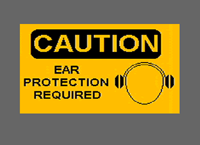 Émilie Pitoiset
Émilie Pitoiset
Caution
August 2001
Émilie Pitoiset's experimental and creative sound space offers the user no interactivity; on the contrary, the artist appropriates the visitor's own personal space. The latter is duly warned of a possibly painful experience: "Caution, EAR PROTECTION REQUIRED"
Exceptionally brutal, strident feedback screeches and pierces our ears, and all we can think of is shutting it up. In addition to this audio attack, countless little windows open, close, run across the screen, and there's nothing to do but let the feedback propagate and devastate everything.
The user suddenly has no control over the interface, the browser, or any application. Deprived of interactivity and any possibility of dialogue with his computer, he can only wait for the work to exhaust itself. After the "crash", we wait nervously a moment; we are definitely not sure that the audio and visual experiment has left our system intact. A reboot is in order, as the "feedback-virus" may still have some life in it.
Pitoiset's approach is at the very least extreme and is significant of an iconoclastic attitude shared by some network artists - like Jodi, with its OSS project - who literally take navigation systems hostage.
Caution puts the user in a tough, even unpleasant position, given that it appropriates absolute control of the computer, conveying only the image of a substantial bug in the user's system. By this approach, the artist directly attacks the machine and pushes it toward an accident, a computing accident resembling the audio accident that feedback represents. If feedback is indeed an "accident", it is also a perpetual audio movement, echoed here by the proliferation of pop-ups and uncontrollable visual objects. The intentional production of feedback risks imploding the speakers - just what every user eventually worries about, caught up in this infernal system in spite of himself.
Is this to say that the artist implicitly places herself in a position of dominance over our computer systems and, in the end, over us? Her approach may not be quite that extreme, but Caution reminds us that our now hyper-computerized society is not as reliable as we are lead to believe. In no time, like a "hacker", the artist sabotages our computers - machines in which we place blind and constant faith. The critique seems justified, since we remain powerless before this aggression. While computer technology now rules over our lives, some, strengthened by their knowledge of networks and languages, can, like Caution, devastate and pirate any machine.
Rest assured, while this work creates some passing worries, it remains harmless. Pitoiset creates the worry and sense of aggression precisely to confront us with the obvious: we all use computers every day, but we are still not comfortable with their underlying codes and languages. An incident (an accident), and we are rendered helpless before a recalcitrant screen, an obstinate keyboard, a machine that refuses to cooperate. Computing certainly generates much progress, but it also creates worry and uncertainty. As proof, we might recall the doubt and apprehension on going into 2000. In the end we were not all that sheltered from a widespread bug... and the one Pitoiset provokes suggests that the dominance of the machine remains something that should concern us and of which we should be especially wary.
C.P.
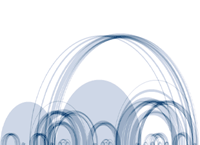 Martin Wattenberg
Martin Wattenberg
The Shape of Songs
June 2001
Music is indeed a fundamental element of the Web experience. It is one of the most coveted web object, a focal point of interests and desires to the point of turning it into a fetish. On whatever side of the cyberspace barricades we are, the fact is that somehow we have arrived at entangling music into knots. In the midst of these hunts and thirsts, perhaps we are loosing the thread of its immense potential.
Without pretence or forcefulness, Martin Wattenberg is asking a simple and seemingly innocent question : "What does music look like?" The Shape of Songs presents an opportunity to stop the gold rush fever by going back to the source and looking behind the scenes of Web music itself in order to reclaim its essential qualities of abstractness and transparency.
Through a custom made software musical scores in the shape of midi files are dissected to their basic structure and design. Any style of music available on the Net can be visualised, "from the deep structure of Bach to the crystalline beauty of Philip Glass" (Wattenberg). The drawing includes all the tracks and one can listen to the music played by humans on a synthesiser. The drawings of the scores are arched. They are static while following the inner movement of the piece. This simplification is shocking at first regarding the ways in which music is made available on the Web. In the context of the lustrous colours and shapes in which music is served to the user, yet free access to it is increasingly limited, this experience is unexciting to such a degree that it becomes perplexing and disarming.
Drawn in pale, blue-grey colour, the arches are neutral and non intrusive. They are rendered prismatic. Although their character is functional by the fact that they indicate the musical skeleton of a midi score, they assume as well a metaphorical role as arches and threshold through which one's perception can travel. They act as strings which resonate a different, concealed voice of music.
Explaining "the method behind" the project, the artist says : " The diagrams in The Shape of Songs display musical form as a sequence of translucent arches. Each arch connects two repeated, identical passages of a composition. By using repeated passages as signposts, the diagram illustrates the deep structure of the composition."
With this project which draws on the idea of seeing music (or by extension how a drawing sounds) and touching the artist also touches on the notion of synaesthesia in the total work of art and on the Internet as a total medium just as opera and cinema were examined as such. Although remotely and with some irony, the Wattenberg investigates the possibilities of a total net.art experience.
By revealing the rhythm and patterns of musical pieces as Midi files, the artist demonstrates the potential of accessibility and interactivity in creation. He dismantles the false aura of music on the Web and restore its intrinsic gracefulness. Operating the new maladies of music, almost like ear and eye surgery, The Shape of Songs is an act of disentangling the knots which have hold over music on the web through a different, subtle kind of musical webbing. Software is used as an analytical tool, an instrument of the logos of threading and unthreading digitally.
R.D.
 [the user]
[the user]
Silophone
June 2000
Sound
-Architecture
-Interactive Art
-Connected Environments
-Musique Concrète
Architecture is pregnant with sounds, reverberations and echoes derived from our environment. Silophone, by the collective [The User], transforms an emblematic industrial Montréal structure, Silo #5, into an interactive musical instrument. The disaffected silo, located in the Old Port, is part of a cluster of industrial-centric architectures lining the St-Lawrence seaway which are linked to railway networks across the continent. Cavernous - and inscribed within modern urban developments - the silos formerly used to store grain have been closed and empty since 1996. They have also gained notoriety, having been described as a "masterpiece of modern architecture"1 by architect Le Corbusier. The Silophone project acts as mediator between the silo and the public, inviting one to email or telephone in unique sounds (or select from a series of archived digital files) to be played into the belly of the vacant structure. The emanated sounds are thus transformed by the architecture and are rebroadcast to the public via the Web site.
Space plays a catalytic role in the production of sound art. As Achim Wollscheid notes, today "...space with its assembly of sound producers, listeners and sound producing objects becomes the INSTRUMENT·"2 Works such as the John Cage's 4'33" (four minutes and thirty three seconds of "silence") heightened our sensitivity to the acoustic environments in which we hear. Silophone, although a collaborative intervention fed by many "players" across the globe, speaks to the acoustic make-up of our surrounding architecture. Reminds us Giancarlo Toniutti "Sound as a phenomenon is thus part of space, since it can only exist in space."3 A project such as this has its roots in the Musique Concrète movement of 1950s-60s Paris. The musicians (or sound artists) of Musique Concrète (Pierre Schaeffer, Michel Chion, Pierre Henry, Bernard Parmegiani and others) focused on the very substance of "concrete" reality such as: soundscape and noise with an emphasis on the frenetic complexities of urban life; and the city street as a place of "ambiance." The composers of Musique Concrète were keenly interested in creating music through the very devices of recording technology of the time (magnetic tape, phonograph records etc.) Notes Brandon LaBelle:
"From here, this point of concreteness, musical composition takes shape through a self-reflexive interest in the very materiality of the recording medium. This materiality is never absent from what we hear - it continually surfaces within the compositions."4
An emphasis on collage incorporating environmental sounds, urban noises, machinery, public interaction, studio effects, and vocal/musical fragments is at the crux of these investigations. Similarly, Silophone is a "material" instrument - a vessel for sound manipulations - incorporating a panoply of sound fragments played through the technology of today: the Internet.
Creating a bridge between a fading industrial and an evanescent technological revolution - and negotiating between disaffected architectures in the urban core and networked information technologies across the globe - Silophone participates in the revitalization and sensitization of our architectural/sonic environments.
Notes
1- See: http://www.silophone.net/eng/about.html
2- Achim Wollscheid, "Does the Song Remain the Same?", (Ed.) Brandon LaBelle & Steve Roden, Site of Sound: of Architecture & the Ear, Errant Bodies Press in association with Smart Art Press, Los Angeles, 1999, p. 8.
3- Giancarlo Toniutti, "Space as a Cultural Substratum", (Ed.) Brandon LaBelle & Steve Roden, Site of Sound: of Architecture & the Ear, Errant Bodies Press in association with Smart Art Press, Los Angeles, 1999, p. 39.
4- Brandon LaBelle, "Architecture of Noise", (Ed.) Brandon LaBelle & Steve Roden, Site of Sound: of Architecture & the Ear, Errant Bodies Press in association with Smart Art Press, Los Angeles, 1999, p. 54.
V.L.
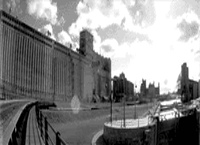
Sound's ability to travel through space, to circulate and cross distances, creating a space that escapes visual scope, makes it open to the spatial expansion provided by a communications network like the Web. In this respect, as opposed to radio or music sites, the Silophone project takes many more possibilities into account than those of distribution and broadcasting. Using Silo #5 in Montreal as an acoustic space, it invites us to consider how the environment amplifies, distorts, and appropriates sound. And by renewing connections with the world in the context of digital technologies and inviting the participant to likewise, it emphasizes the importance of physical place, of the possible and desired exchanges between it and cyberspace.
In his article Online Sound and Virtual Architecture, Sean Cubitt points out that, "in communicative feedback", particularly significant for some ethnic communities, "the medium of communication is a living part of the message, its materiality evidence of connectedness"1 - which contrasts with traditional models of communications whose objective is to deliver a message as unaltered as possible and to repudiate the means of transmission. In Silophone, the sound's trajectory - back and forth between the silo and the participant - and its transformation by the silo are brought into the foreground and made manifest. In the time required for this two-way process - the perceptible 40-second delay seems long - the participant remains in a state of expectancy and alertness. Silence, as much as the sound altered by the silo and returned to the spectator, invites the latter to become aware of the spatiotemporal experience he lends himself to: "Silence, in such a moment, is a pressing engagement with where you are. Suddenly, you are where a sound should be. The effort to hear is simultaneously the effort to define a place."2 The reverberating sound, like an echo, or kind of distorting mirror, offers a reflection of oneself, changed by the environment through which it is transmitted; thus, the significance of the action resides in this reverberation that includes the individual in his environment, virtual and real.
Notes
1- Sean Cubitt, "Online Sound and Virtual Architecture",Homestudio Audiolab, 1996
2- Sean Cubitt, "Sound Aphorisms", Rhizome, 1996
S.P.
N.B. The reviews of [the user] by Valérie Lamontagne and Sylvie Parent were published originally on their web site:
LOCATION.DISLOCATION
Reviews by Ned Bouhalassa, Rossitza Daskalova, Patrick Lafond, Valérie Lamontagne, Sylvie Parent,
Cécile Petit, Bernard Schütze and Brad Todd


